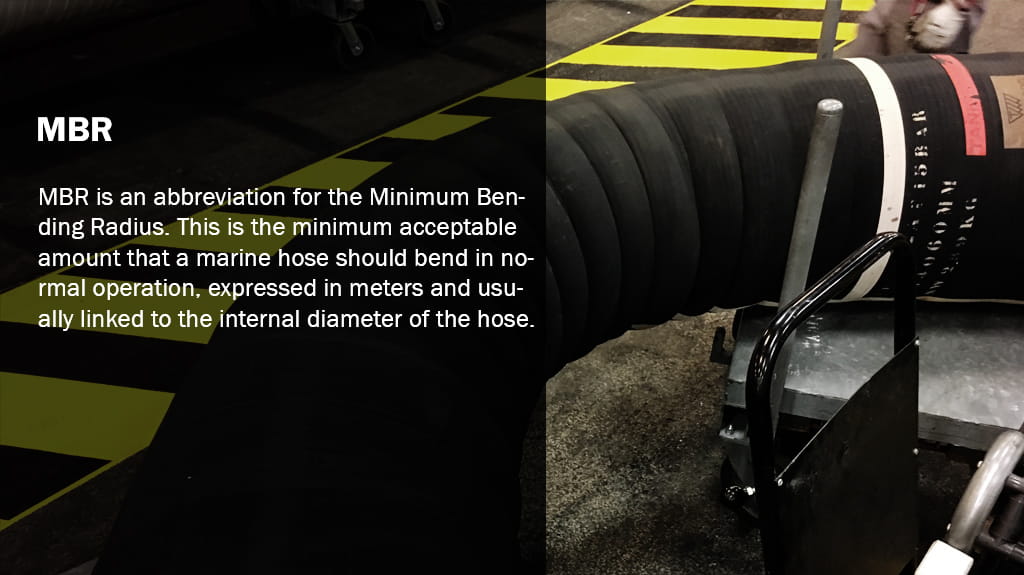
MBR
[MBR is an abbreviation for the Minimum Bending Radius. This is the minimum acceptable amount that a marine hose should bend in normal operation, expressed in meters and usually linked to the internal diameter of the hose.
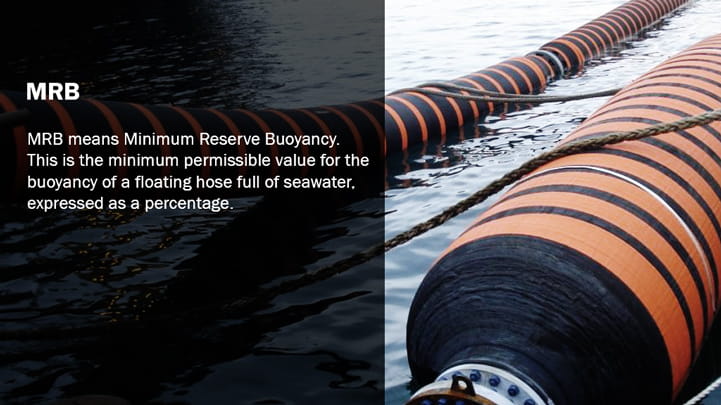
MRB
MRB means Minimum Reserve Buoyancy. This is the minimum permissible value for the buoyancy of a floating hose full of seawater, expressed as a percentage.

Wearing indicator
Wearing Indicator is a layer of coloured rubber integrated into the structure of a hose and/or close to the hose structure to quickly and simply indicate the condition of the hose.The Wearing Indicator layer can show the limit of abrasion and tearing of the outer cover, allowing action before unrepairable damage is caused. The wearing indicator is mainly used for the subsea hoses in CBM/MBM configurations in contact with the seabed.
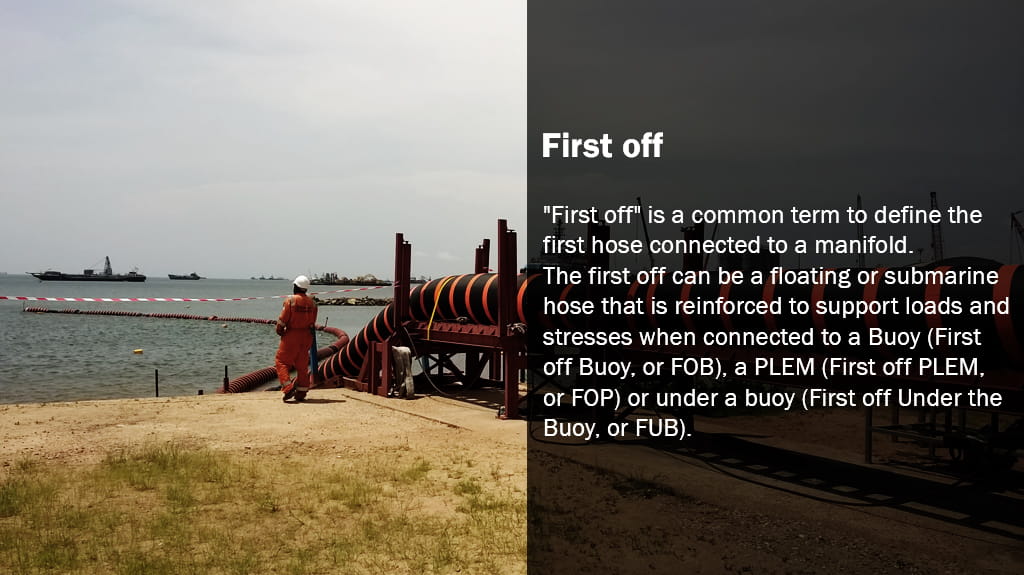
First off
"First off" is a common term to define the first hose connected to a manifold. The first off can be a floating or submarine hose that is reinforced to support loads and stresses when connected to a Buoy (First off Buoy, or FOB), a PLEM (First off PLEM, or FOP) or under a buoy (First off Under the Buoy, or FUB).
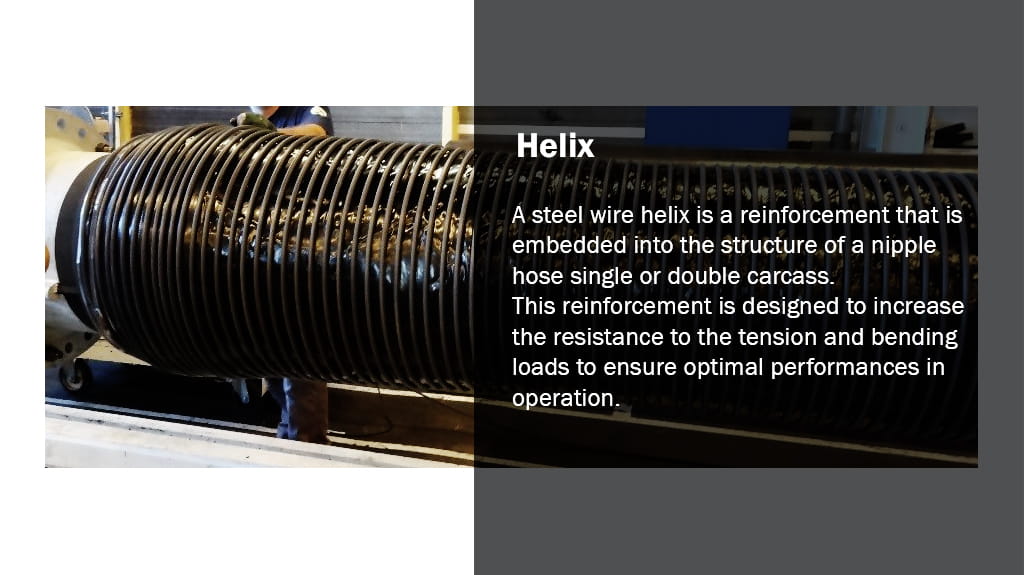
Helix
A steel wire helix is a reinforcement that is embedded into the structure of a nipple hose single or double carcass. This reinforcement is designed to increase the resistance to the tension and bending loads to ensure optimal performances in operation.

Winkerlights
Winkerlights are waterproof LED navigational aids that mark the location of the floating hose strings in the hours of darkness. They are used to signal and secure floating offloading lines, and have a sun switch to ensure that the light only comes on in the dark.

PipeLine End Manifold (PLEM)
A PipeLine End Manifold, or PLEM, is used to combine, distribute, control or monitor fluid flow. The subsea manifold is installed on the seabed and utilises a combination of piping and/or valves to act as flow-routing hardware that connects virtical subsea hoses and horizontal pipelines

Vapour Return Line
Import LNG Transfer
During the transfer of LNG, the level of liquid in the LNG carrier storage tank drops, while the amount in the receiving tank rises. The vapour return line is used to transfer vapour back to the original tank to compensate the amount of shifted liquid, helping to maintain the pressure in both tanks at the desired level.
Export LNG Transfer
For export LNG transfer, the vapour return line is uses to send back all of the boil-off gas (BOG) produced during the transfer to the export facility to re-liquify it.
During the transfer of LNG, the level of liquid in the LNG carrier storage tank drops, while the amount in the receiving tank rises. The vapour return line is used to transfer vapour back to the original tank to compensate the amount of shifted liquid, helping to maintain the pressure in both tanks at the desired level.
Export LNG Transfer
For export LNG transfer, the vapour return line is uses to send back all of the boil-off gas (BOG) produced during the transfer to the export facility to re-liquify it.
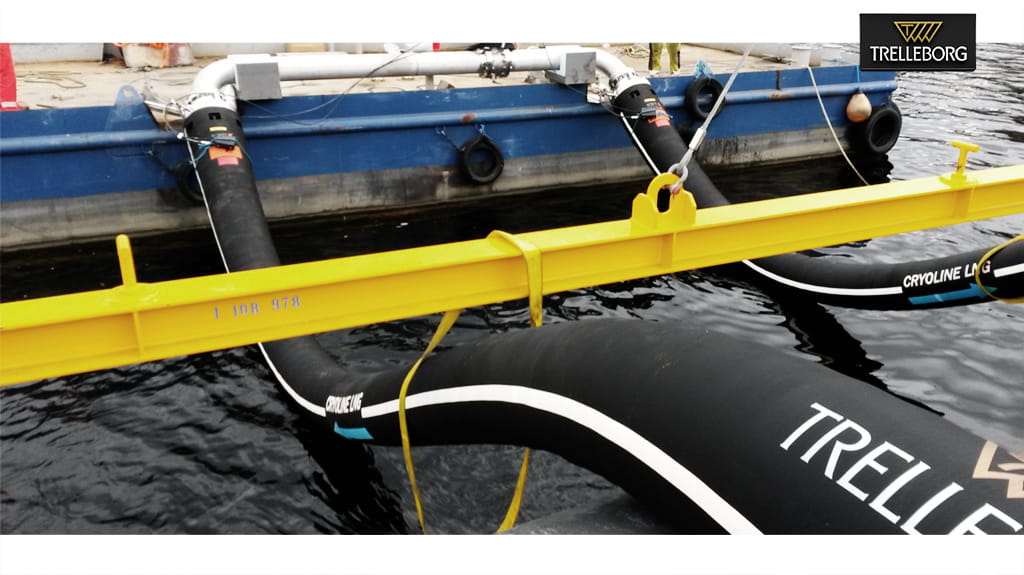
The U-Value
Thermal transmittance, also known as U-value, is the rate of transfer of heat through a structure (in W/m²K).
The better-insulated the structure is, the lower the U-value will be.
The better-insulated the structure is, the lower the U-value will be.

MBM
Multi Buoy Mooring, also known as Conventional Buoy Mooring, is a simple, reliable import solution for crude oil, refined petroleum or LPG, from a shuttle tanker to storage thanks or a refinery. Deployed near to shore, the system connects a steel pipeline to the onshore installation, alongside a flexible subsea string for safe transfer of liquids, with multiple configuration options.
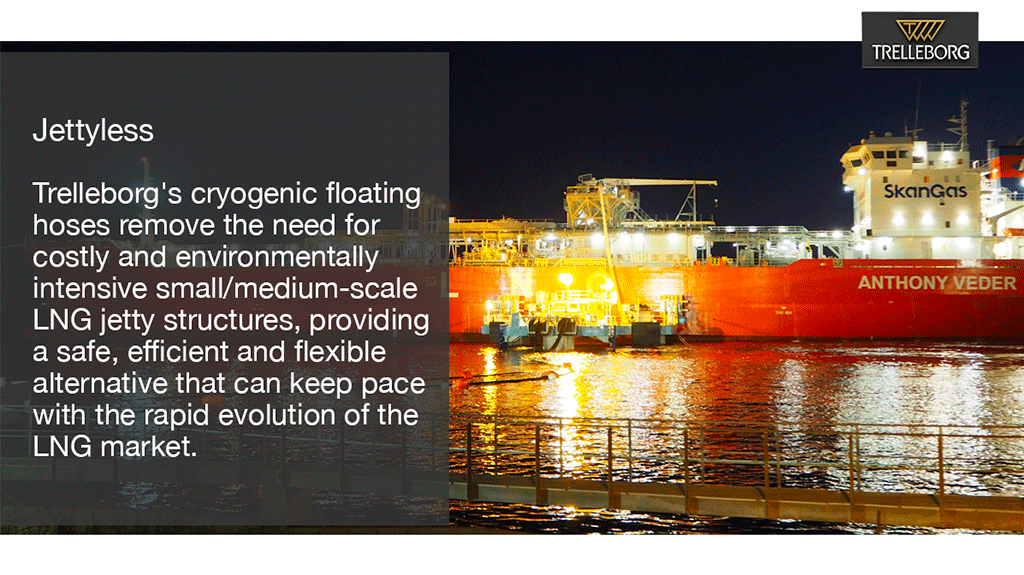
Jettyless
Trelleborg's cryogenic floating hoses remove the need for costly and environmentally intensive small/medium-scale LNG jetty structures, providing a safe, efficient and flexible alternative that can keep pace with the rapid evolution of the LNG market.
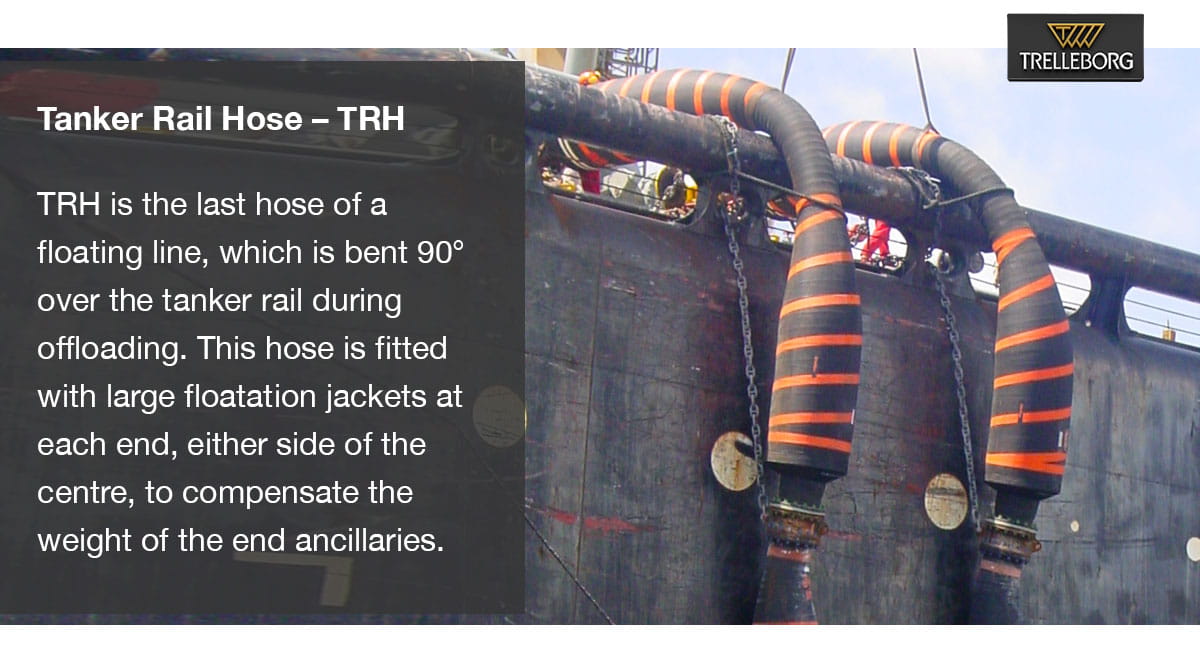
TRH - Tanker Rail Hose
TRH is the last hose of a floating line, which is bent 90° over the tanker rail during offloading. This hose is fitted with large floatation jackets at each end, either side of the centre, to compensate the weight of the end ancillaries.
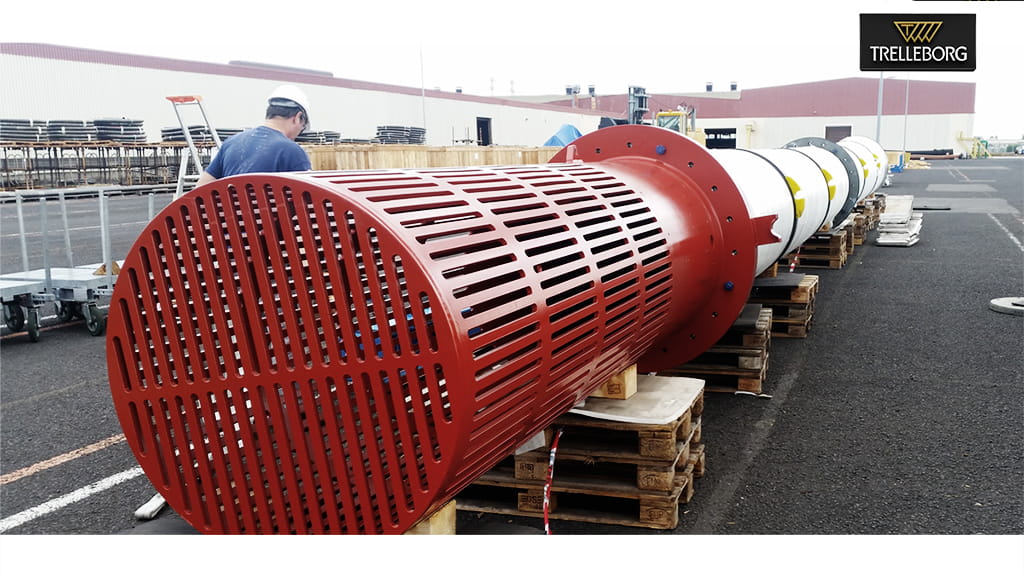
Strainer
Strainer (n): A filtration device fitted at the inlet of a seawater intake riser to prevent fish and marine fauna from being sucked in.
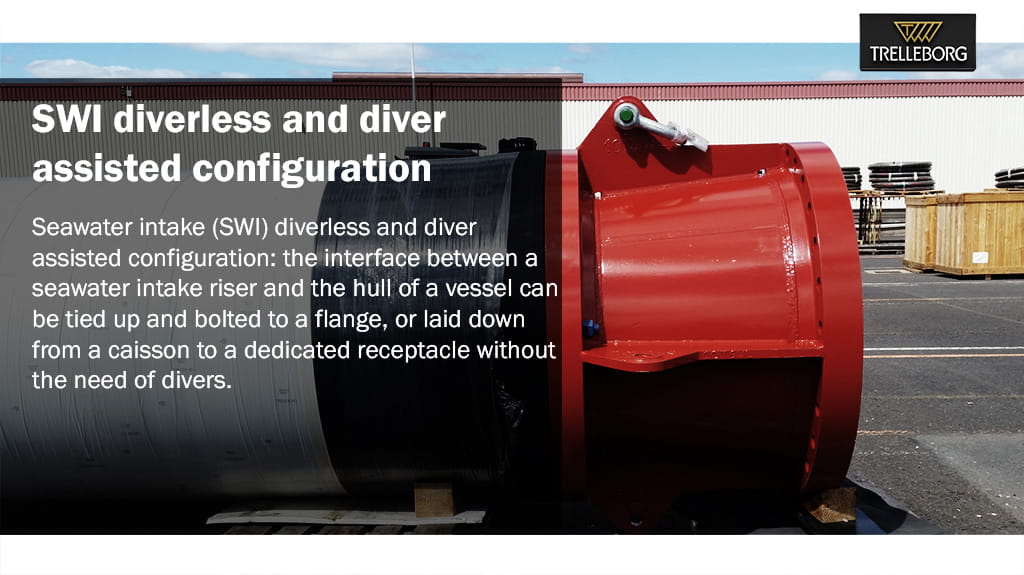
Seawater intake (SWI) diverless and diver assisted configuration
The interface between a seawater intake riser and the hull of a vessel can be tied up and bolted to a flange, or laid down from a caisson to a dedicated receptacle without the need of divers.
For diver-assisted configuration the interface is made by a spool piece.
For diverless configuration, the interface is made by a riser head and a riser seat integrated directly to the hull during construction.
For diver-assisted configuration the interface is made by a spool piece.
For diverless configuration, the interface is made by a riser head and a riser seat integrated directly to the hull during construction.

ECA
THe Emissions Control Areas (ECA) refer to specific areas where regulations minimise airbone emissions from ships as part of MARPOL (maritime pollution) Protocol. ECAs impose caps on the amount of sulfur oxide, nitrogen oxide or fine particulates that can be present in ship emissions. Vessels travelling in ECAs need to be careful about the type of fuel they use, and may even switch fuels when operating inside/outside ECAs.
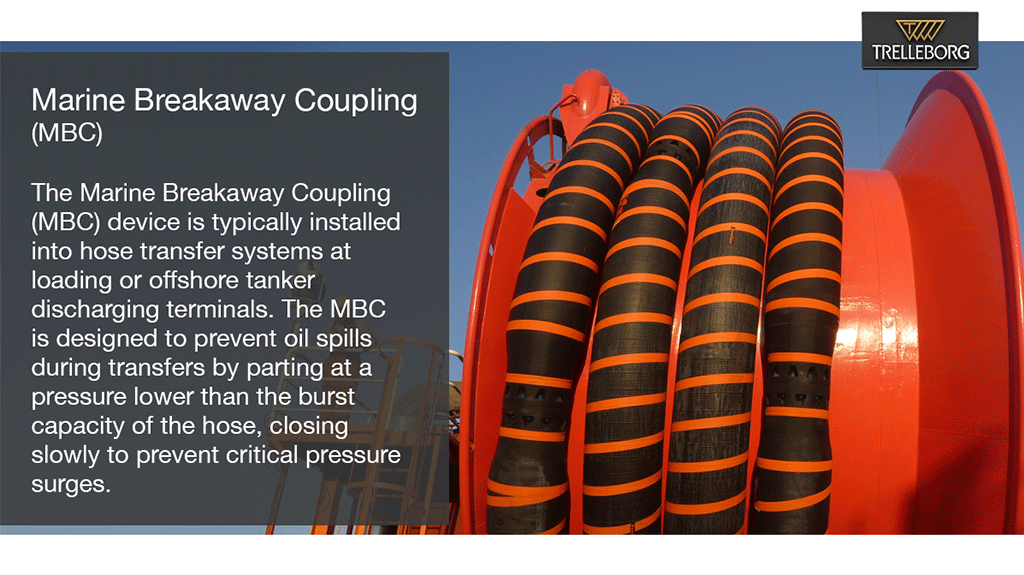
MBC
The Marine Breakaway Coupling (MBC) device is typically installed into hose transfer systems at loading or offshore tanker discharging terminals. The MBC is designed to prevent oil spills during transfers by parting at a pressure lower than the burst capacity of the hose, closing slowly to prevent critical pressure surges.

ELA - End-Line Ancillary
EndLine Ancillary equipment is used to help operators to lift, connect and secure a Tanker Rail Hose (the hose that goes over the side of the ship) to a tanker's mid-ship manifold - the connection point for a hose. An ELA is usually made up of various components, such as a metallic piece to lift lugs, a butterfly valve, camlock couplings, a light blind flange and snubbing chains to pick up chains and buoys.
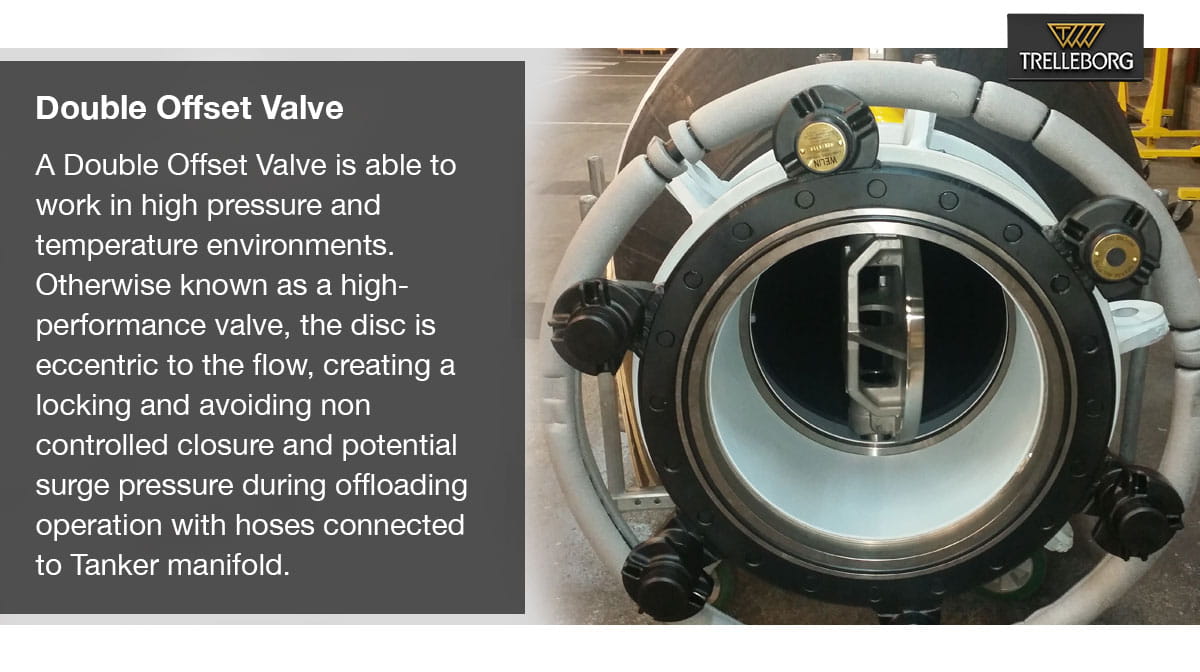
Double Offset Valve
A double Offset Valve is able to work in high pressure and temperature environments. Otherwise known as a high-performance valve, the disc is eccentric to the flow, creating locking and avoiding non controlled closure and potential surge pressure during offloading operation with hoses connected to Tanker manifold.

Integrated Bend Stiffener
IBS stands for Integrated Bending Stiffener : IBS is a built in bending stiffener fitted at the end of a hose at the manifold - the hardware to which the hose connects, or at all connections between hoses. The bending stiffener protects the end of the hose from bending too much, and provides a smooth transition of bending stiffness by gradually increasing the outer diameter from the central area to the flange.

FKM
FKM refers to the 'fluoroelastomer' category according to ASTM (American Society of Testing and Materials) when classifying materials. This type of rubber is resistant to heat and resists chemcial reactions. Hence, it is particularly suitable as the inner liner of a marine hose when handling corrosive fluids like high purity acids. They also presents a very low gas permeability and excellent resistance to oils.
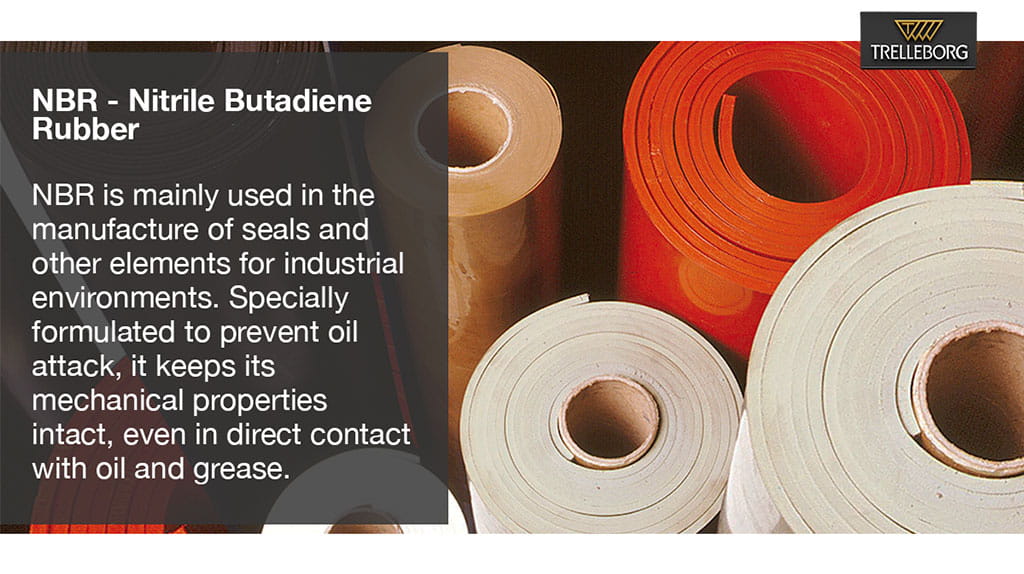
NBR - Nitrile Butadiene Rubber
NBR is mainly used in the manufacture of seals and other elements for industrial environments. Specially formulated to prevent oil attack, it keeps its mechanical properties intact, even in direct contact with oil and grease.
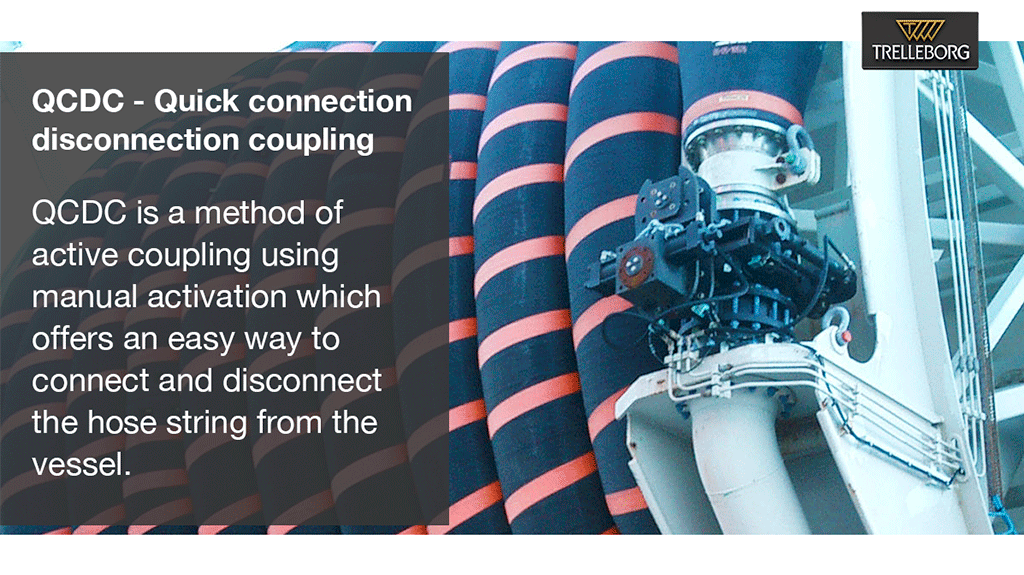
QCDC
QCDC - Quick connection disconnetion coupling is a method of active coupling using manual activation which offers an easy way to connect and disconnect the hose string from the vessel.
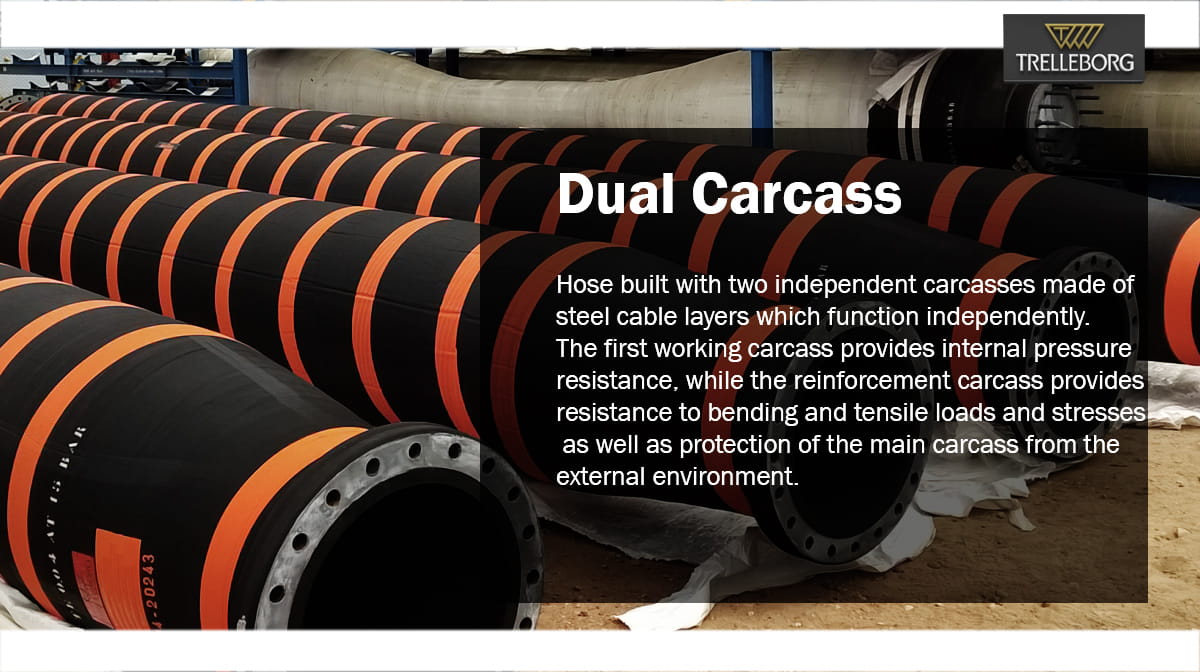
Dual Carcass
Hose built with two independent carcasses made of steel cable layers which function independently.
The first working carcass provides internal pressure resistance, while the reinforcement carcass provides resistance to bending and tensile loads and stresses as well as protection of the main carcass from the external environment.
The first working carcass provides internal pressure resistance, while the reinforcement carcass provides resistance to bending and tensile loads and stresses as well as protection of the main carcass from the external environment.

Double Carcass
Hose built with carcass made of a textile layer and steel helix reinforcement, forming a single carcass.
The Double carcass consists to an additional carcass above the first, and a leak detection system (LDS) in the event of failure in the first carcass.
The second carcass contains oil in the event of a failure in the first.
The Double carcass consists to an additional carcass above the first, and a leak detection system (LDS) in the event of failure in the first carcass.
The second carcass contains oil in the event of a failure in the first.
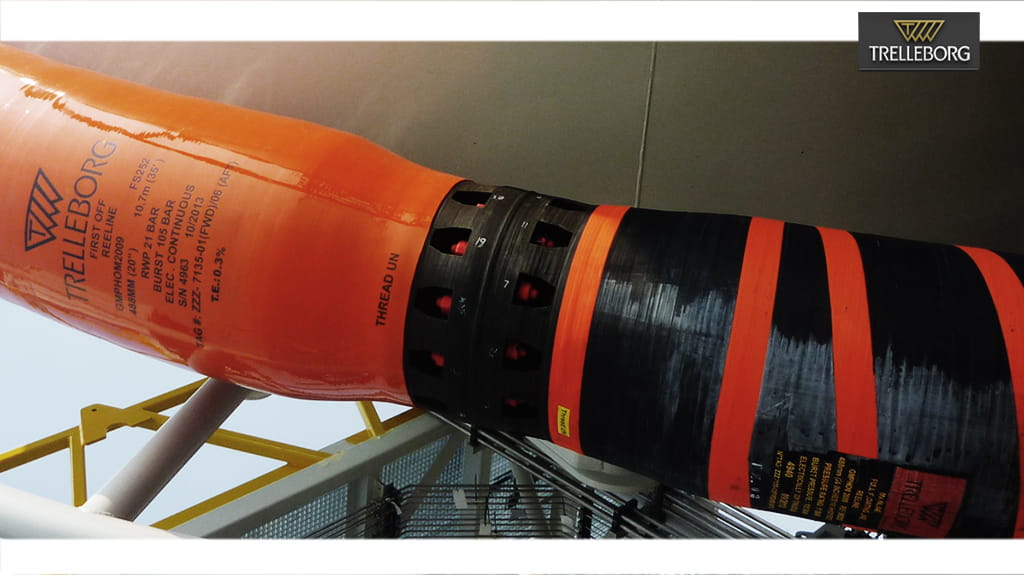
Orange PolyUrethane “PU”
Orange PolyUrethane “PU” is an extra anti-abrasion outer cover for the floating and submarine hoses which reducing repairing due to wear and cuts in operation.
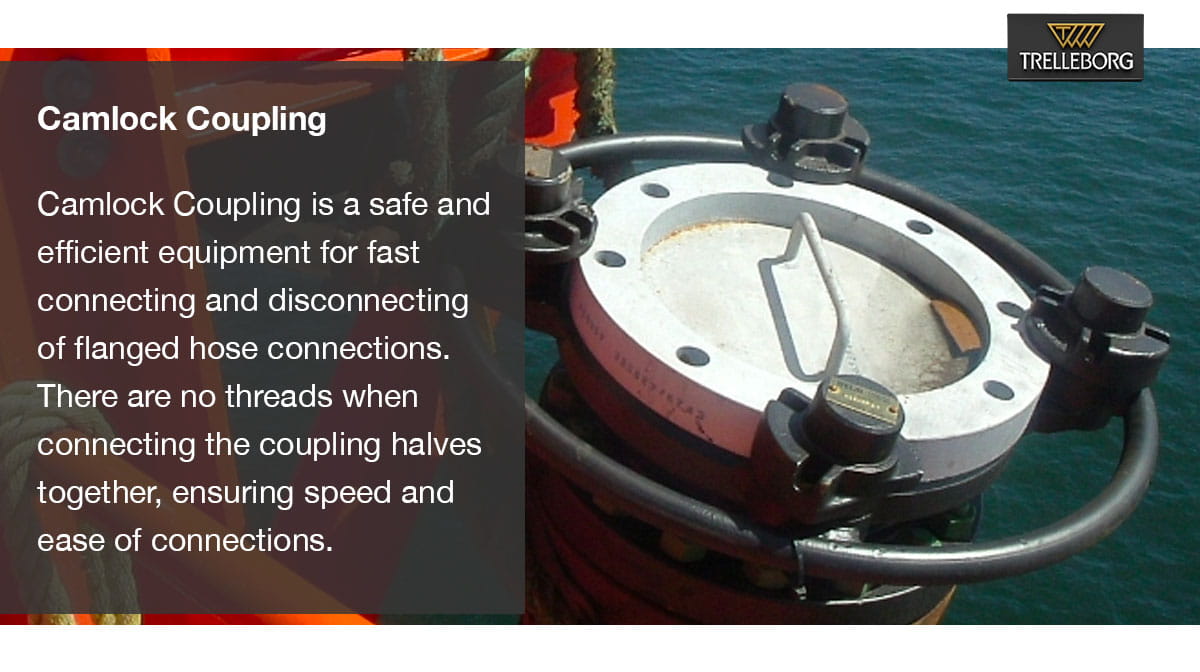
Camlock Coupling
Camlock Coupling is a safe and efficient equipment for fast connecting and disconnecting of flanged hose connections. There are no threads when connecting the coupling halves together, ensuring speed and ease of connections.
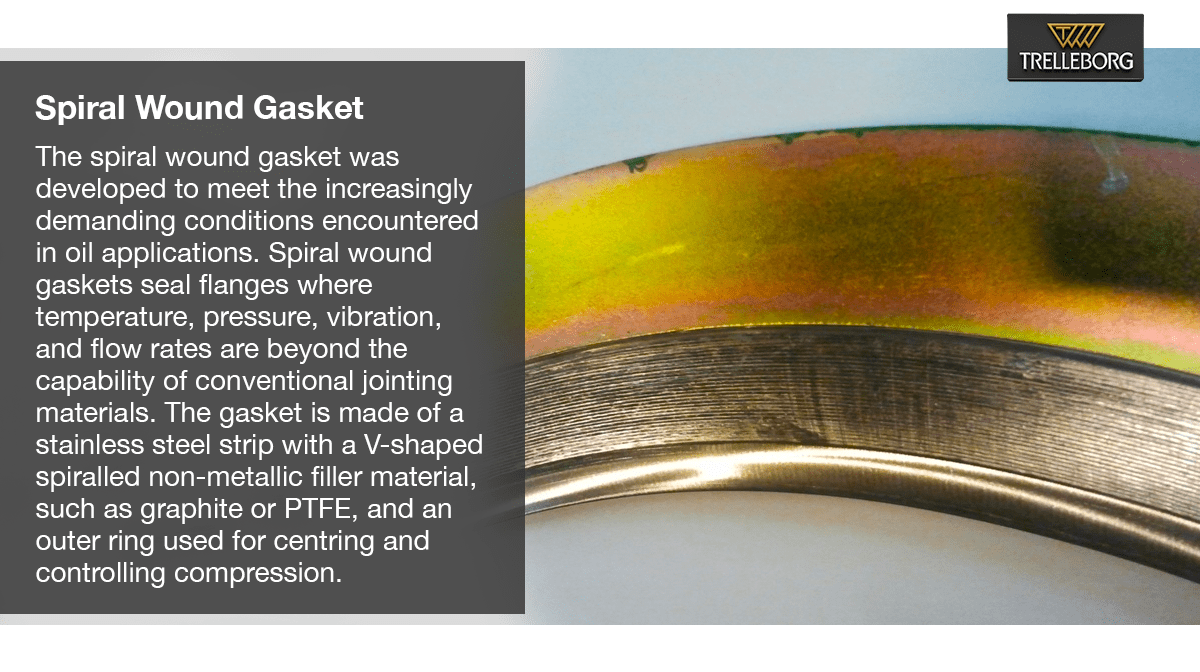
Spiral Wound Gasket
The spiral wound gasket was developed to meet the increasingly demanding conditions encountered in oil applications. Spiral wound gaskets seal flanges where temperature, pressure, vibration, and flow rates are beyond the capability of conventional jointing materials. The gasket is made of a stainless steel strip with a V-shaped spiralled non-metallic filler material, such as graphite or PTFE, and an outer ring used for centring and controlling compression.

New solution for ship-to-ship
Trelleborg is launching a new solution for ship-to-ship (STS) transfer, in the form of KLELINE STS, bringing new thinking to the field of STS oil transfer. We take a look at how it works and why it makes sense to challenge conventional wisdom on STS transfer.

Boil-off gas
LNG tankers are designed to carry natural gas in liquid form at a temperature of – 163°C, close to the vaporization temperature. Despite tank insulation designed to limit the admission of external heat, even a small amount of it will cause slight evaporation of the cargo. This natural evaporation, known as boil-off is unavoidable and has to be removed from the tanks in order to maintain the cargo tank pressure.

Cross Tightening
Cross tightening is a bolt tightening method most commonly used on a simple square pattern or circular bolt pattern. Tightening bolts using these patterns ensures an even clamping distribution accross the part in question, such as a flange, and reduces the impact of preloading on the previously tightened bolts.
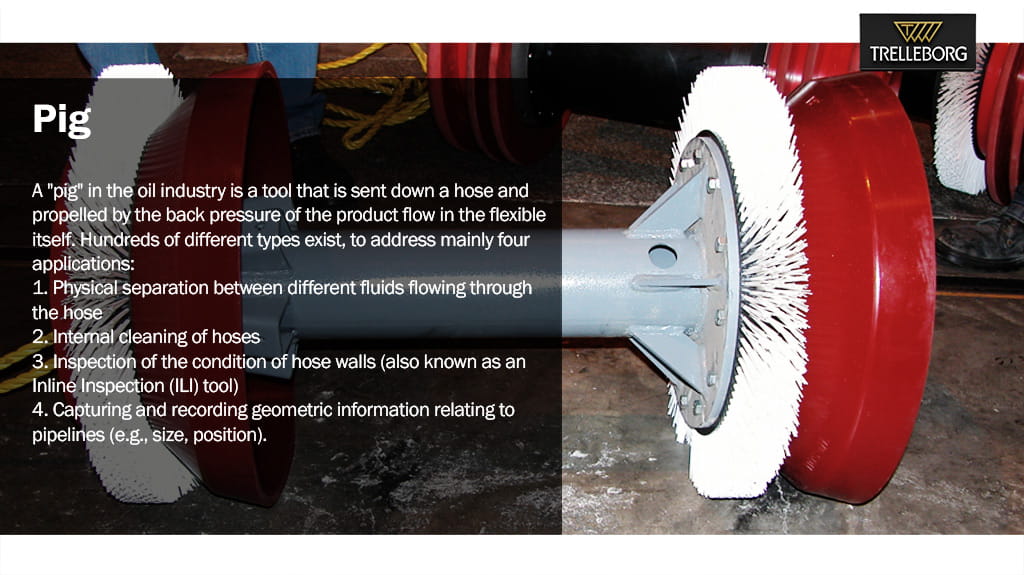
PIG
A "pig" in the oil industry is a tool that is sent down a hose and propelled by the back pressure of the product flow in the flexible itself. Hundreds of different types exist, to address mainly four applications:
1. Physical separation between different fluids flowing through the hose
2. Internal cleaning of hoses
3. Inspection of the condition of hose walls (also known as an Inline Inspection (ILI) tool)
4. Capturing and recording geometric information relating to pipelines (e.g., size, position).
1. Physical separation between different fluids flowing through the hose
2. Internal cleaning of hoses
3. Inspection of the condition of hose walls (also known as an Inline Inspection (ILI) tool)
4. Capturing and recording geometric information relating to pipelines (e.g., size, position).

Nippleless Flange
Compact flange at the end of a hose, fully embedded in rubber, using a continuous inner liner and integrated gasket.
This creates a perfect seal between conveyed product and hose structure, resulting in a hose that survives harsher conditions for longer.
This creates a perfect seal between conveyed product and hose structure, resulting in a hose that survives harsher conditions for longer.

Butterfly Valve
A butterfly valve is used to isolate or regulate fluid flow. The valve has a small disc that is mounted on a rotating shaft. When the disk is at right angle, the valve is open, allowing a full flow. This can be turned incrementally to control the passage of fluid, until it is fully closed.
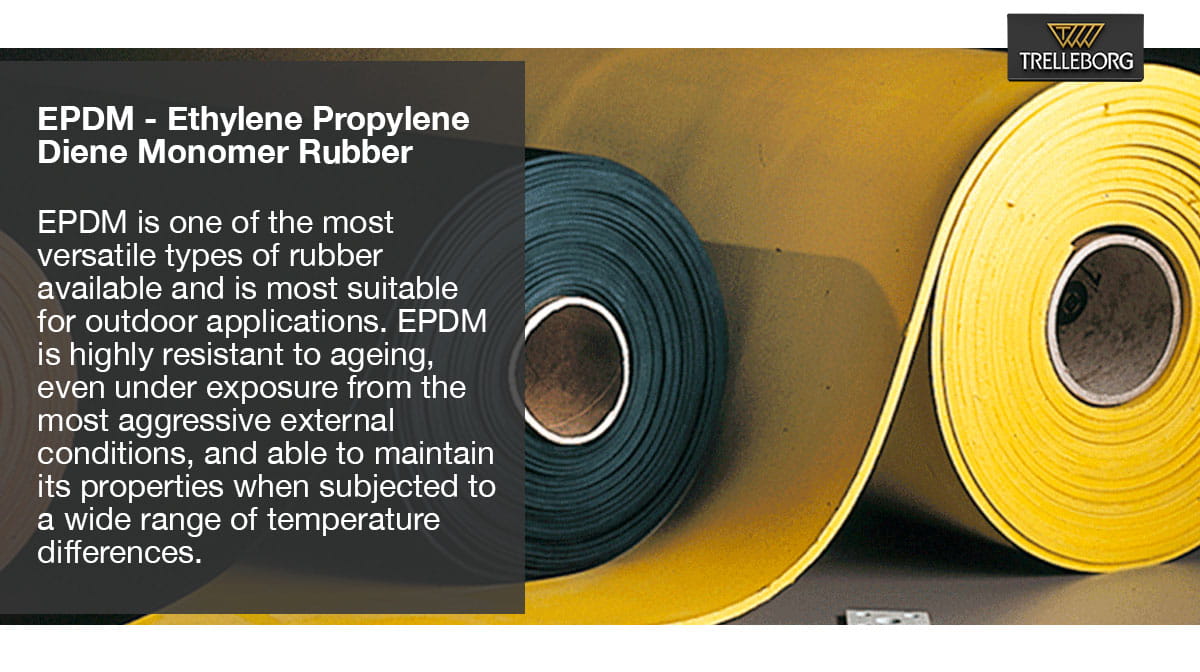
EPDM - Ethylene Propylene Diene Monomer Rubber
EPDM is one of the most versatile types of rubber available and is most suitable for outdoor applications. EPDM is highly resistant to ageing, even under exposure from the most aggresive external conditions, and able to maintain its properties when subjected to a wide range of temperature differences.

Hydraulic Wrench
A Hydraulic Wrench is designed to apply a controlled predetermined amount of torque to a properly lubricated fastener, to tighten or loosen a connection through the use of hydraulics. Hydraulics wrenches are used to their tightening accuracy, which increases joint integrity whilst preventing under and over torquing, saving time by avoiding failed pressure tests and repeat bolting.

VDB - Vendor Data Books
Vendor data books consist of documentation that must be supplied by vendors as part of a contract to supply equipment. Vendor data is most commonly supplied progressively and includes documents and drawings against the requirements laid out in the contract.
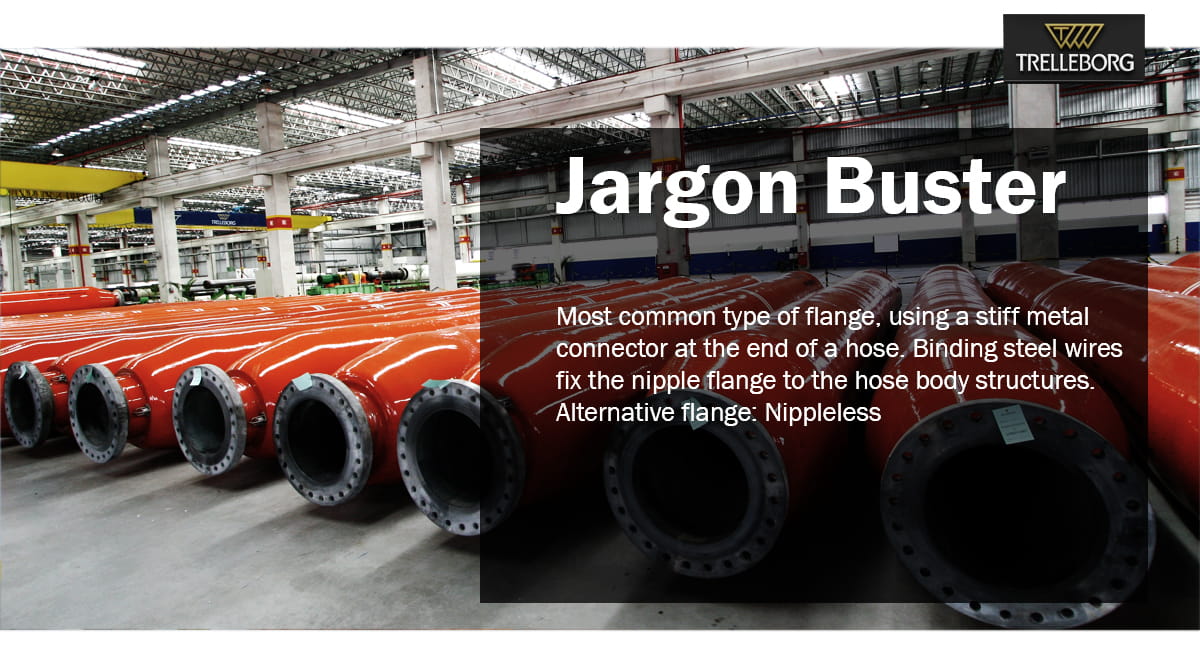
Nipple Flange
Most common type of flange, using a stiff metal connector at the end of a hose, Binding steel wires fix the nipple flange to the hose body structures.
Alternative flange: Nippleless.
Alternative flange: Nippleless.
